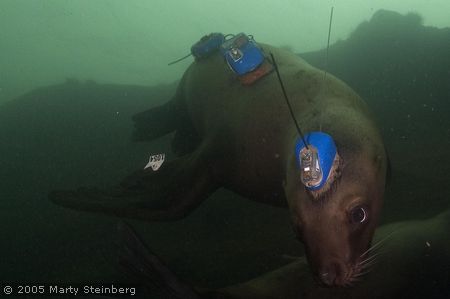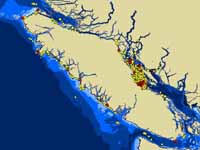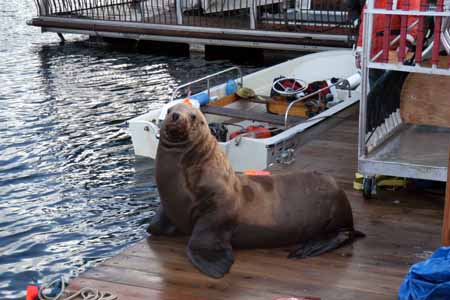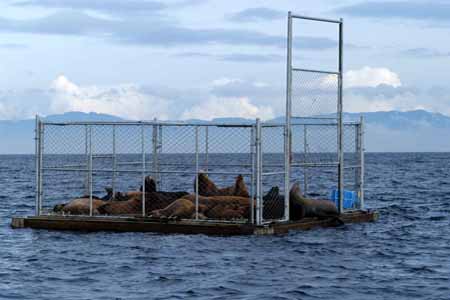Hornby Island Sea Lion Study - January 2005
 For
the last five years I've been traveling to
Hornby Island, BC to dive
and play with the Stellar sea lions that migrate there during the winter
months to wait to feed on the annual herring spawn. They are an incredibly friendly
bunch who are accustomed to divers visiting and interacting with them.
This year we ran into one special pup who appeared to be "instrumented".
The dive lodge owners were aware of the animal, but not aware of any studies
under way in their area at the time. I sent some photos of him to Donna
Gibbs at the Vancouver Aquarium whom I had met on previous specimen
collecting trips in British Columbia and asked if she had heard of any
studies going on at Hornby. She had not but told me she'd ask around the
local marine biologists' community. A month later I received a response from
Peter Olesiuk from the Canadian Department of Fisheries and Oceans.
Turns out the blue headed guy I ran into on Hornby was one of twelve
instrumented animals that are part of this year's study on foraging behavors.
Peter generously gave his time to explain the details of the study to me by
email. I have found the information on the behaviors and travel
patterns of these guys so interesting from Peter's study that it makes you
look at sea lions in the water in a whole new way, curious how long they've
been at their current site and how far they've traveled in the last few
months. Below is the full context of Peter Olesiuk's combined mail
thread on the study. More images from the trips can
be found here.
For
the last five years I've been traveling to
Hornby Island, BC to dive
and play with the Stellar sea lions that migrate there during the winter
months to wait to feed on the annual herring spawn. They are an incredibly friendly
bunch who are accustomed to divers visiting and interacting with them.
This year we ran into one special pup who appeared to be "instrumented".
The dive lodge owners were aware of the animal, but not aware of any studies
under way in their area at the time. I sent some photos of him to Donna
Gibbs at the Vancouver Aquarium whom I had met on previous specimen
collecting trips in British Columbia and asked if she had heard of any
studies going on at Hornby. She had not but told me she'd ask around the
local marine biologists' community. A month later I received a response from
Peter Olesiuk from the Canadian Department of Fisheries and Oceans.
Turns out the blue headed guy I ran into on Hornby was one of twelve
instrumented animals that are part of this year's study on foraging behavors.
Peter generously gave his time to explain the details of the study to me by
email. I have found the information on the behaviors and travel
patterns of these guys so interesting from Peter's study that it makes you
look at sea lions in the water in a whole new way, curious how long they've
been at their current site and how far they've traveled in the last few
months. Below is the full context of Peter Olesiuk's combined mail
thread on the study. More images from the trips can
be found here.
Marty Steinberg.
I am a marine biologist specializing in marine mammals,
and along with my colleagues Steve Jeffries from Washington Fish and
Wildlife, and Andrew Trites from University of British Columbia, are
conducting a study on foraging behaviour of Steller sea lions. We deployed
instruments on 12 Steller sea lion in January at Norris Rocks off Hornby
Island this year. Our goal is to determine how foraging patterns vary
between sex- and age-classes, which will hopefully lead to a better
understanding of why populations in Alaska have been declining. A leading
hypothesis is that young animals are nutritionally stressed, especially if
high-quality energy-rich prey are unavailable. The instruments we deployed
include a back-mounted recorder that monitors feeding activity (indicated by
stomach temperature transmitted from a pill in the stomach) that will be
released after two weeks (we've already recovered that package from the
animal you photographed), another back-mounted time-depth recorder that is
monitoring haulout and diving patterns, which we will plan on releasing and
recovering in April, and a head-mounted satellite tag that is providing
information on movements. The instruments are colour-coded, and the animal
you photographed off Hornby is our smallest animal - a 222 lb fellow about a
year-and-a-half old that is still nursing. Compared to older animals, our
preliminary finding suggest these young dependent animals, and their
mothers, may be less mobile than other sex- and age-classes, and thus more
limited in their ability to take advantage of locally and seasonally
available prey resources. These young animals and their mothers seem to
hang around the same area for extended periods, where we've had other
animals move hundreds of kilometers (two have almost circumnavigated
Vancouver Island).
By the way,there is also a branded Steller sea
lion in the photos - 145Y. The animal was branded as a pup on Rogue Reef
off Oregon in July 2003 by my colleagues with ODF&W (Oregon Dept of Fish &
Wildlife). I'm keeping track of resightings for them and will pass this one
along. They are tracking the branded animals to determine survival and
reproductive rates, and we are also learning much about movements.
Interestingly, moms with young animals tend to disperse quite far from
rookeries where they breed, but then the youngsters tend to park on a
particular haulout site while mom is off foraging.
 It
will be a while before our study is complete and all the information
processed. We tagged 12 sea lions this year, and hope to do 12-15 again
next year. The attached map shows the locations received by satellite
(yellow indicates at-sea locations, and red indicates on land, with larger
circles representing more accurate positions). As you can see, the main
foraging area has been in the northern Strait of Georgia, where herring
stocks have been staging in preparation for spawning. One of our goals is
to monitor sea lion movements as the herring spawn and disperse, and sea
lions switch to other prey. The complete story won't be told until we
recover the time-depth recorders in April, which will provide very detailed
information on diving and haulout behaviour (at 10 sec intervals over a
period of several months!). Although most of the animals have been foraging
in the northern Strait of Georgia, you'll notice a few positions out on the
west coast. These represent the longer-range movements of two subadult
males. One headed south out through Juan de Fuca and up the west coast of
the Island and is currently sitting at Hope Island off the north tip of
Vancouver Island. The other headed north through Johnstone Strait and then
down the west coast of Vancouver Island, and is currently sitting at Cape
Alava off the Washington coast. Interestingly, these animals seem to
know where all the traditional haulout areas are situated, and make frequent
stopovers at them.
It
will be a while before our study is complete and all the information
processed. We tagged 12 sea lions this year, and hope to do 12-15 again
next year. The attached map shows the locations received by satellite
(yellow indicates at-sea locations, and red indicates on land, with larger
circles representing more accurate positions). As you can see, the main
foraging area has been in the northern Strait of Georgia, where herring
stocks have been staging in preparation for spawning. One of our goals is
to monitor sea lion movements as the herring spawn and disperse, and sea
lions switch to other prey. The complete story won't be told until we
recover the time-depth recorders in April, which will provide very detailed
information on diving and haulout behaviour (at 10 sec intervals over a
period of several months!). Although most of the animals have been foraging
in the northern Strait of Georgia, you'll notice a few positions out on the
west coast. These represent the longer-range movements of two subadult
males. One headed south out through Juan de Fuca and up the west coast of
the Island and is currently sitting at Hope Island off the north tip of
Vancouver Island. The other headed north through Johnstone Strait and then
down the west coast of Vancouver Island, and is currently sitting at Cape
Alava off the Washington coast. Interestingly, these animals seem to
know where all the traditional haulout areas are situated, and make frequent
stopovers at them.
*******************************************
Peter F. Olesiuk
Marine Mammal Biologist
Head, Seal and Sea Lion Program
Conservation Biology Section
Department of Fisheries and Oceans
Pacific Biological Station
Nanaimo, B.C.

Photo courtesy of Peter Olesiuk

Photo courtesy of Peter Olesiuk
 For
the last five years I've been traveling to
Hornby Island, BC to dive
and play with the Stellar sea lions that migrate there during the winter
months to wait to feed on the annual herring spawn. They are an incredibly friendly
bunch who are accustomed to divers visiting and interacting with them.
This year we ran into one special pup who appeared to be "instrumented".
The dive lodge owners were aware of the animal, but not aware of any studies
under way in their area at the time. I sent some photos of him to Donna
Gibbs at the Vancouver Aquarium whom I had met on previous specimen
collecting trips in British Columbia and asked if she had heard of any
studies going on at Hornby. She had not but told me she'd ask around the
local marine biologists' community. A month later I received a response from
Peter Olesiuk from the Canadian Department of Fisheries and Oceans.
Turns out the blue headed guy I ran into on Hornby was one of twelve
instrumented animals that are part of this year's study on foraging behavors.
Peter generously gave his time to explain the details of the study to me by
email. I have found the information on the behaviors and travel
patterns of these guys so interesting from Peter's study that it makes you
look at sea lions in the water in a whole new way, curious how long they've
been at their current site and how far they've traveled in the last few
months. Below is the full context of Peter Olesiuk's combined mail
thread on the study. More images from the trips can
be found here.
For
the last five years I've been traveling to
Hornby Island, BC to dive
and play with the Stellar sea lions that migrate there during the winter
months to wait to feed on the annual herring spawn. They are an incredibly friendly
bunch who are accustomed to divers visiting and interacting with them.
This year we ran into one special pup who appeared to be "instrumented".
The dive lodge owners were aware of the animal, but not aware of any studies
under way in their area at the time. I sent some photos of him to Donna
Gibbs at the Vancouver Aquarium whom I had met on previous specimen
collecting trips in British Columbia and asked if she had heard of any
studies going on at Hornby. She had not but told me she'd ask around the
local marine biologists' community. A month later I received a response from
Peter Olesiuk from the Canadian Department of Fisheries and Oceans.
Turns out the blue headed guy I ran into on Hornby was one of twelve
instrumented animals that are part of this year's study on foraging behavors.
Peter generously gave his time to explain the details of the study to me by
email. I have found the information on the behaviors and travel
patterns of these guys so interesting from Peter's study that it makes you
look at sea lions in the water in a whole new way, curious how long they've
been at their current site and how far they've traveled in the last few
months. Below is the full context of Peter Olesiuk's combined mail
thread on the study. More images from the trips can
be found here.
